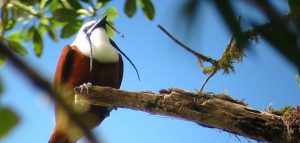The Bell Bird

The bell bird (Procnias tricarunculata) is a bird endangered species found only in Central America from southeastern Honduras to western Panama (Stiles and Skutch 1989). The bell bird male has a beautiful white plumage and coffee three carúnculos hanging from the peak, and an impressive song that can be heard more than 1 km away. Females are smaller, quieter and with a plumage that allows them to camouflage themselves very well in the forest canopy.
This bird has a limited range in Central America and it seems that there are only four populations of significant size: Monteverde is the center of the population of the Cordillera de Tilarán, which extends from the north of Cacao Volcano to the south of San Ramon . These birds breed at high elevations, lower montane rain forest and montane forest on the Atlantic side (late February to June). Males emerge first of these areas and move to the very humid montane forest of the Pacific slope in March and April. Then down to the humid forest transition and use this habitat as a breeding area post until September. In September, Monteverde migrate to the lower parts of the Atlantic coast in the Reserve Indio-Maiz located in the southeastern part of Nicaragua. The type of habitat is tropical rain forest. In December return to Costa Rica crossing the Continental Divide and is approximately two months in the tropical rainforest and montane humid in the Pacific slope (December through February). They migrate back to Monteverde across the Arenal region.
Thus the inhabitants of a region can be recognized by their particular accent, the bell bird (Procnias tricarunculatus) changes its song depending on the area you live.
According to the Costa Rican ornithologist Julio Sanchez, the bell does not sound like such rather the sound emitted is as a kind of ‘boinj’ changing rhythmically and melodically to differentiate at least three “dialects” means one of the population of Talamanca, other birds of Monteverde and finally those of Nicaragua.
According to Sanchez, like children learn to speak with help from adults, the “dialect” of this bird species is “a learned singing, where the young birds approach the ‘older’ to learn from them “.
Sanchez stressed that this learning occurs in the first seven years of life of the animals.
It was also found that this species of bird has the ability to modify their song throughout his life. They also are able to track the song of other males. The latter is a factor of competition for females.
This species, however, is at risk of extinction due to deforestation, which is why as a solution to this problem, several organizations are working on a conservation project in Monteverde, which seeks to create a biological corridor to facilitate their transition from the Arenal National Park to the mouth of the river Abangares, Guanacaste.
